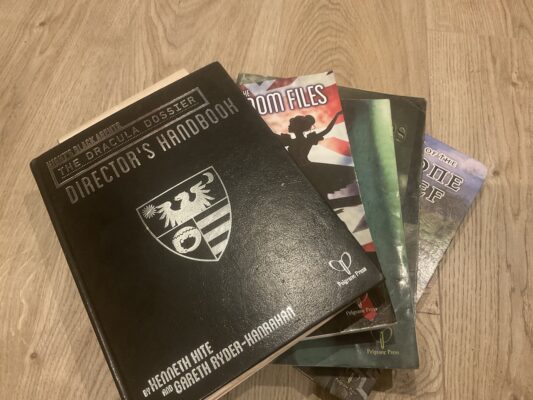 It’s been a while since I’ve written one of these Page XX pieces. In the intervening months, I’ve been working on a whole host of different adventures, ranging from classic Cthulhu mythos to epic fantasy to political drama to different flavours of weirdness. As part of the process of adventure writing, there are ten questions I ask myself while developing a scenario. They’re not GUMSHOE-specific, although GUMSHOE definitely helps with some of them.
It’s been a while since I’ve written one of these Page XX pieces. In the intervening months, I’ve been working on a whole host of different adventures, ranging from classic Cthulhu mythos to epic fantasy to political drama to different flavours of weirdness. As part of the process of adventure writing, there are ten questions I ask myself while developing a scenario. They’re not GUMSHOE-specific, although GUMSHOE definitely helps with some of them.
- How do the characters get involved? Does it make sense?
Many games provide a default answer, like “it’s the PC’s job to investigate strange events” or “they’re space cops”. If there isn’t a built-in hook, then you’ve got to provide one – and there, you’ve got to be a little careful. Wary characters may bug out if the danger seems disproportional to the reward (“we got hired to find a missing lawyer, and now we’re fighting vampires?”); paranoid players may be suspicious of an innocent hook (“this ‘old friend’ – how much do I actually know about him?”).
The more co-incidental the involvement of the player characters, the more players suspect a trap or twist, so you may need to either reassure them or make the hook especially trustworthy.
- How does it connect to the player characters?
A good adventure is more than a generic episode-of-the-week that could happen to any group of characters – it should have resonance for your specific player characters. Even if they’re just random adventurers who got hired for this mission, it should still connect to them on some level.
This can be:
- Personal – my old friend/family member/clan is involved in this adventure.
- Emotional – this situation mirrors an ongoing dispute or dynamic within the group of player characters, or in a character’s backstory.
- Showcase – this situation really shows off some advantage or ability of my character. A character whose concept is ‘ex-space smuggler’ gets to shine in an adventure about space smugglers.
- Advancement – by completing this adventure, I’ll move towards achieving some long-held desire or goal (which can be as simple as “hey, I can get a cool axe from these guys”).
When writing adventures for publication, you usually don’t know who the characters will be, so scatter lots of potential connections for a GM to pick up on.
- What makes this situation different?
Every game has a classic, default setup for adventure. The dungeon crawl. The haunted house. The bank heist. The murder mystery. Often, you’ll find yourself returning to that core setup again and again – so each time, look for some twist or cosmetic tweak to make this iteration of the same story a bit different. The dungeon’s underwater, it’s a haunted art gallery, it’s not a bank it’s a military base, the victim’s still alive but in a coma (and might wake up at a dramatic moment in the adventure). A small but vivid twist is enough to make a familiar plot fresh.
- What do the player characters do?
I find myself asking this question most often when I start with an interesting premise, especially one inspired by a historical event (“wow, I’ve got to do something based on the wreck of the Batavia!”). A roleplaying adventure needs to have space for the player characters to take action and affect the story – ideally, that’s by far the largest ‘space’ within the conceptual confines. If most of the adventure is about the motivations, backstory and actions of non-player characters, it’s time to stop and rethink. Everything needs to hinge on the actions of the player characters.
This question is especially important in the early section of an adventure. Scenarios have a momentum all their own, and it’s important to overcome the initial inertia. Hooking the players and playing through the first scene is only half the job – the scenario needs to provide a clear course (or, better, choice!) of action early on.
- How do they find out this particular piece of information?
How do the characters find out what’s going on, and why? It’s fine to have some things remain a mystery, or only be hinted at in the adventure, but the players should always be able to discover most of the backstory and . Whenever you note down a fact about the situation or backstory, think about how the players might find that out – or, if there’s no reasonable way for them to discover it, question whether or not it’s needed.
A little hidden information adds texture and helps the GM deal with the unexpected by giving added context, but too much drowns the GM in irrelevancies.
- What do they need to do to resolve the situation?
Sometimes, the answer to this question’s obvious – most F20 scenarios end in a climatic battle where the player characters slay the bad guys. If the scenario starts with a murder, then solving the murder is part of the resolution.
But what then? Do the player characters have to arrest the murderer? Find definitive proof? Thwart the murderer’s ongoing murder spree? Banish the alien entity he summoned with that first murder? Cover it up to avoid embarrassing their family?
Ideally, there are several possible ways to resolve the situation, and the players have to discover them or choose between them.
You don’t need to answer this question – it’s fine to leave the resolution wholly in the hands of fate, or the players – but then you definitely need a way to push matters to a crux point where some sort of resolution happens. (Or ask yourself: in this game, with these players, will leaving things unresolved be a satisfying ending? Some games are fine with anticlimaxes and messy endings.)
- How do they know how to resolve the situation?
Again, sometimes the answer’s obvious – hitting things works in a lot of games. If the game is one in which the player characters have built-in tools that can be used to manoeuvre events towards a resolution, the answer may be on the sheet. (Swords of the Serpentine, for example, equips player characters with a bunch of connections and factions that can be called upon, letting players hit problems with society).
This question often crops up in mystery games with weird problems – if the threat’s a monster with fangs and claws, you can hit it, but what do you do with, say, a Colour Out Of Space, or the revelation that the whole town’s full of Deep Ones?
Common answers to this question: someone else already resolved the situation, and you’ve got to replicate their solution – the old ‘find the banishing ritual’ routine; the bad guys are clearly attempting to do X, and anything that stops X thwarts them; the bad guys need to do X several times, serial killer style, and breaking the pattern stops them.
Think of this question as a check on your own instincts – you might know how you expect the players to deal with the problem you’ve posed them, but is it an obvious solution from the other side of the GM’s screen? Have you scattered enough clues (or other possible solutions, or the tools for the players to come up with their own solutions) around the adventure?
- How does this help the GM?
A written scenario only comes to life through a GM, so it’s always good to give the GM as many tools as possible to animate that husk of words. This question’s really a grab-bag of possible ways to help the GM, like:
- Is the information structured usefully? If there are a lot of NPCs, would the scenario benefit from a cast list? Does it need a timeline? A map of relationships?
- Are these scenes or encounters that can be dropped? Can any of the clues be made into floating clues?
- Are the wandering monsters/random encounters/weird events that can be dropped in as needed? What about antagonist actions?
- What might come in handy in the heat of play? A list of names for NPCs? Some key descriptive phrases? Precalculated attacks?
Whether writing for your own games or for publication, always think of how the scenario actually hits the table.


